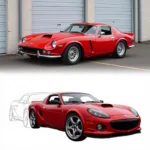Choosing the right stucco color to complement your gray walls can dramatically enhance your home’s curb appeal. Whether you’re aiming for a classic, modern, or bold look, understanding the interplay of colors is key to achieving the perfect contrast with gray.
Creating Stunning Contrast with Gray Walls
Gray is a versatile neutral that provides a fantastic backdrop for a variety of stucco colors. The “best” contrast depends entirely on the specific shade of gray and the overall aesthetic you’re aiming for. For instance, a light gray wall pairs beautifully with darker stucco shades, creating a bold and contemporary feel. Conversely, a dark gray wall can be accented with lighter stucco for a subtle yet sophisticated look. How to select the stucco color will be one of the most important questions you need answered during this process.
Understanding Undertones: The Key to Color Harmony
Before diving into specific color combinations, it’s crucial to identify the undertones of your gray walls. Are they warm grays with hints of beige or brown, or cool grays with blue or purple undertones? Choosing a stucco color with complementary undertones ensures a harmonious and visually appealing result. For example, a warm gray pairs well with earthy stucco tones like beige, cream, or even a warm brown. A cool gray, however, might look best with cooler stucco colors like blues, greens, or even a crisp white.
Popular Stucco Colors for Gray Walls
-
White: A classic choice that provides a clean, crisp contrast against any shade of gray. A bright white stucco against a dark gray creates a dramatic and modern look.
-
Beige/Cream: These warm neutrals offer a softer, more inviting contrast, particularly with warm gray walls.
-
Brown: Deeper shades of brown, such as chocolate or taupe, can create a rich, earthy contrast with lighter gray walls.
-
Black/Charcoal: These bold colors offer a strong, contemporary contrast, particularly effective with lighter grays.
-
Blue/Green: Cooler stucco colors like blues and greens can complement cool gray walls, creating a tranquil and serene atmosphere. Consider shades like navy blue, teal, or sage green.
Considering Architectural Style and Surroundings
The architectural style of your home and the surrounding landscape should also influence your stucco color choice. A Spanish-style home, for example, might benefit from warm stucco tones like terracotta or ochre. A modern home, on the other hand, could look stunning with a crisp white or dark gray stucco. The surrounding landscape can also play a role. If your home is surrounded by greenery, consider a stucco color that complements those natural tones, such as a warm beige or a subtle green.
“Choosing the right stucco color is about more than just contrast. It’s about creating a cohesive and visually appealing look that complements your home’s overall aesthetic,” says renowned color consultant, Amelia Dubois. “Consider the undertones, the architectural style, and even the surrounding landscape to achieve a harmonious result.”
Achieving Your Dream Home Exterior
Ultimately, the best stucco color for your gray walls is the one that best reflects your personal style and enhances your home’s unique character. How to select the stucco color involves careful consideration of undertones, architectural style, and personal preference. Experimenting with different shades and textures can help you visualize the final result and create a truly stunning home exterior. “Don’t be afraid to experiment with different stucco textures as well,” adds Ms. Dubois. “A smooth stucco finish can create a sleek and modern look, while a textured finish can add depth and visual interest.”
FAQ
- Can I use the same color stucco as my gray walls? While you can, it won’t create any contrast. Consider a slightly lighter or darker shade for subtle contrast, or a different color altogether for a bolder look.
- What’s the best way to test stucco colors? Purchase small samples and apply them to a section of your wall to see how they look in different lighting conditions.
- Does the type of stucco affect the color? Yes, different stucco finishes can slightly alter the appearance of the color. Always test your chosen color on a sample area with the desired finish.
- Should I consider the roof color when choosing stucco? Absolutely! The roof color should harmonize with both the wall and stucco colors.
- Can I paint over existing stucco? Yes, you can paint stucco, but proper preparation is crucial for a long-lasting finish.
- How often should I repaint my stucco? Typically, stucco needs repainting every 5-10 years, depending on the climate and exposure to the elements.
- What is the most durable stucco color? Lighter colors tend to be more durable as they absorb less heat, reducing the risk of fading and cracking.
For more information and detailed guides, explore our articles on how to select the stucco color.
We also have other helpful resources on our website that you may find insightful.
If you need further assistance, don’t hesitate to contact us. Call us at 0373298888, email us at [email protected], or visit our office at 86 Cầu Giấy, Hà Nội. Our customer service team is available 24/7 to help you with your color selection and home improvement needs.
